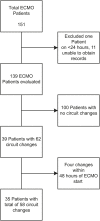Predictors of Oxygenator Exchange in Patients Receiving Extracorporeal Membrane Oxygenation
- PMID: 31239577
- PMCID: PMC6586268
Predictors of Oxygenator Exchange in Patients Receiving Extracorporeal Membrane Oxygenation
Abstract
Thrombosis within the membrane oxygenator (MO) during extracorporeal membrane oxygenation (ECMO) can lead to sudden oxygenator dysfunction with deleterious effects to the patient. The purpose of this study was to identify predictors of circuit exchange during ECMO. This is a single-center, retrospective study of all patients who received ECMO at our institution from January 2010 to December 2015. Changes in potential markers were compared on Day 3 vs. Day 0 before MO exchange. Of the 150 patients who received ECMO, there were 58 MO exchanges in 35 patients. Mean ECMO duration was 21.1 (±12.7) days. D-dimer (DD) (μg/mL) (mean difference -2.6; 95% confidence interval [CI]: -4.2 to -1.1; p = .001) increased significantly in the 3 days leading up to MO exchange, whereas fibrinogen (mg/dL) (mean difference 90.7; 95% CI: 41.8-139.6; p = .001), platelet (PLT) count (1,000/μL) (mean difference 23.3; 95% CI: 10.2-36.4; p = .001), and heparin dose (units/h) (mean difference 261.7; 95% CI: 46.3-477.1; p = .02) decreased. Increasing DD or decreasing fibrinogen, PLT count, or heparin dose may indicate an impending need for MO exchange in patients receiving ECMO. Early identification of these changes may help prevent sudden MO dysfunction.
Keywords: ECMO; oxygenator exchange.
Figures
References
-
- Oliver WC. Anticoagulation and coagulation management for ECMO. Semin CardioThorac Vasc Anesth. 2009;13:154–75. - PubMed
-
- Esper SA, Levy JH, Waters JH, et al. . Extracorporeal membrane oxygenation in the adult: A review of anticoagulation and transfusion. Anesth Analg. 2014;118:731–43. - PubMed
-
- Lubnow M, Philipp A, Dornia C, et al. . D-dimers as an early marker for oxygenator exchange in extracorporeal membrane oxygenation. J Crit Care. 2014;29:473.e1–e5. - PubMed
MeSH terms
Substances
LinkOut - more resources
Full Text Sources
Medical

